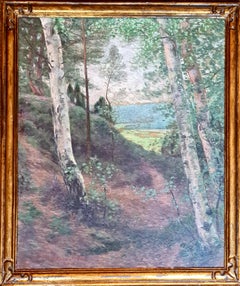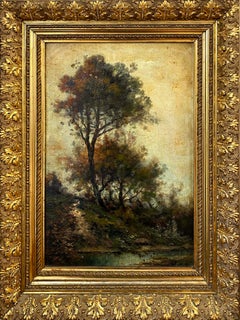Emile Roux Fabre Art
to
3
1
1
3
1
2
1
1
Overall Height
to
Overall Width
to
3
2
1
1
1
1
1
4
3
4
6,998
3,352
2,513
1,213
2
1
1
1
1
Artist: Emile Roux Fabre
The Forest, Large Barbizon School, Oil on Canvas Wooded Landscape
By Emile Roux-Fabre
Located in Cotignac, FR
A French Barbizon School oil on canvas forest view by Emile Roux-Fabre. The painting is signed and dated bottom left with a dedication.
A charming view of forest glade leading out to a valley landscape beyond. The artist has captured the magic feeling of the cool forest shade against the sunshine of the landscape beyond. The texture of the bark on the silver birch trees, the contrast of the leaves on the trees all framing the perspective to the view beyond. An extremely accomplished and atmospheric painting.
The Barbizon school of painters was part of an art movement towards Realism in art, which arose in the context of the dominant Romantic Movement of the time. The Barbizon school was active roughly from 1830 through 1870. It takes its name from the village of Barbizon, France, on the edge of the Forest of Fontainebleau, where many of the artists gathered. Most of their works were landscape paintings, but several of them also painted landscapes with farmworkers, and genre scenes of village life. Some of the most prominent features of this school are its tonal qualities, colour, loose brushwork, and softness of form.
The leaders of the Barbizon school were: Théodore Rousseau, Charles-François Daubigny, Jules Dupré, Constant Troyon, Charles Jacque, and Narcisse Virgilio Díaz. Jean-François Millet lived in Barbizon from 1849, but his interest in figures with a landscape backdrop sets him rather apart from the others. Jean-Baptiste-Camille Corot was the earliest on the scene, first painting in the forest in 1829, but his work has a poetic and literary quality which sets him somewhat apart. Other artists associated with the school, often pupils of the main group, include: Henri Harpignies, Albert Charpin, François-Louis Français and Émile van Marcke.
In 1824 the Salon de Paris exhibited works of John Constable, an English painter. His rural scenes influenced some of the younger artists of the time, moving them to abandon formalism and to draw inspiration directly from nature. Natural scenes became the subjects of their paintings rather than mere backdrops to dramatic events. During the Revolutions of 1848 artists gathered at Barbizon to follow Constable's ideas, making nature the subject of their paintings. The French landscape became a major theme of the Barbizon painters.
Millet extended the idea from landscape to figures — peasant figures, scenes of peasant life, and work in the fields. In The Gleaners (1857), for example, Millet portrays three peasant women working at the harvest. Gleaners are poor people who are permitted to gather the remains after the owners of the field complete the main harvest. The owners (portrayed as wealthy) and their laborers are seen in the back of the painting. Millet shifted the focus and the subject matter from the rich and prominent to those at the bottom of the social ladders. To emphasize their anonymity and marginalized position, he hid their faces. The women's bowed bodies represent their everyday hard work.
In the spring of 1829, Jean-Baptiste-Camille Corot came to Barbizon to paint in the Forest of Fontainebleau, he had first painted in the forest at Chailly in 1822. He returned to Barbizon in the autumn of 1830 and in the summer of 1831, where he made drawings and oil studies, from which he made a painting intended for the Salon of 1830; "View of the Forest of Fontainebleau'" (now in the National Gallery in Washington) and, for the salon of 1831, another "View of the Forest of Fontainebleau"'. While there he met the members of the Barbizon school: Théodore Rousseau, Paul Huet, Constant Troyon, Jean-François Millet, and the young Charles-François Daubigny.
During the late 1860s, the Barbizon painters attracted the attention of a younger generation of French artists studying in Paris. Several of those artists visited Fontainebleau Forest to paint the landscape, including Claude Monet, Pierre-Auguste Renoir, Alfred Sisley and Frédéric Bazille. In the 1870s those artists, among others, developed the art movement called Impressionism and practiced 'plein air' painting. In contrast, the main members of the school made drawings and sketches on the spot, but painted back in their studios.
The Post-Impressionist painter Vincent Van Gogh studied and copied several of the Barbizon painters as well, including 21 copies of paintings by Millet. He copied Millet more than any other artist. He also did three paintings in Daubigny's Garden.
The Barbizon painters also had a profound impact on landscape painting in the United States. This included the development of the American Barbizon school by William Morris Hunt. Several artists who were also in, or contemporary to, the Hudson River School studied Barbizon paintings for their loose brushwork and emotional impact. A notable example is George Inness, who sought to emulate the works of Rousseau. Paintings from the Barbizon school also influenced landscape painting in California. The artist Percy Gray...
Category
Early 20th Century Barbizon School Emile Roux Fabre Art
Materials
Canvas, Oil
Provence
By Emile Roux-Fabre
Located in Houston, TX
Classic etching of Provence by French artist E. Roux-Fabre, circa 1930.
Original artwork on paper displayed on a white mat with a gold border. Mat fits a standard-sized frame. Archi...
Category
1930s Emile Roux Fabre Art
Materials
Etching
French Etching Bridge
By Emile Roux-Fabre
Located in Houston, TX
French etching of arched bridge by artist E. Roux-Fabre, circa 1930.
Original artwork on paper displayed on a white mat with a gold border. Mat fits a ...
Category
1930s Emile Roux Fabre Art
Materials
Etching
Vintage Landscape Etching - The Flock
By Emile Roux-Fabre
Located in Houston, TX
Vintage black and white etching of a farmer leading his flock of sheep to a pasture bordered by a small village by French artist Emile Roux Fabre, circa 1930. Signed in pencil lower ...
Category
1930s Emile Roux Fabre Art
Materials
Paper, Ink
Related Items
Antique Barbizon School Oil Painting Original Gold Frame Rich Colors Fall
Located in Buffalo, NY
Original Barbizon school painting in an original period frame.
Framed 24 x 18
Unframed 18 x 12
Category
19th Century Barbizon School Emile Roux Fabre Art
Materials
Oil, Canvas
Mother dog and her puppies, 19th Century French Barbizonf armhouse painting
Located in Norwich, GB
An charming 19th century dog painting depicting a mother dogue and her exuberant topsy turvy pups by the farmhouse barns or cowsheds , with a young child given them a fuss!
Dating from ca 1860-70, the oil on canvas is unsigned, but bears on the verso a rather special stamp from colour and artists supplies merchant Paul Durand-Ruel (1831-1922). Paul Durand-Ruel is known as the legendary art dealer who launched, almost single handedly, the Impressionist movement. He represented Monet, Pissarro, Sisley, Renoir in his Paris, London and New York Galleries.
Like his father Jean Marie Durand, Durand Ruel had started as both a merchant of art supplies, and dealer. Often, these two activities overlapped, as he would supply cash strapped artists who left paintings as security. Paul Durand Ruel was one of the first to discover Barbizon artist...
Category
1860s Barbizon School Emile Roux Fabre Art
Materials
Canvas, Oil
H 27.17 in W 31.89 in D 0.4 in
TODAY - large format photograph of conceptual motivational billboard at night
By Frank Schott
Located in San Francisco, CA
large scale original photograph of a billboard signage against ultramarine blue night sky from a series of conceptual motivational messages on iconic Americana signs...
Category
21st Century and Contemporary Conceptual Emile Roux Fabre Art
Materials
Archival Paper, Photographic Paper, Archival Pigment, Archival Ink, Giclée
H 48 in W 75.5 in D 0.03 in
Spanish school landscape with river oil painting Spain
Located in Barcelona, Barcelona
Oil on canvas glued to board.
Oil measures 25x40 cm.
Frameless.
Illegible signature.
Category
1920s Barbizon School Emile Roux Fabre Art
Materials
Oil, Board, Canvas
Antique 19th Century French Signed Oil Painting Lady Walking in the Woods
Located in Cirencester, Gloucestershire
Walking in the Woods
French School, late 19th century
signed Maurice Bernard
signed oil on canvas, framed
framed: 24 x 28 inches
canvas: 21 x 26 inches
provenance: private collection...
Category
Late 19th Century Barbizon School Emile Roux Fabre Art
Materials
Canvas, Oil
Venice Beach Seascape, Long Wave, Nautical Scene in Blue Tones, Limited Edition
By Kind of Cyan
Located in Barcelona, ES
This is an exclusive handprinted limited edition cyanotype.
This beautiful cyanotype is titled "Long Wave in Venice Beach" and it shows an outstanding wave in one of the most iconic ...
Category
2010s Realist Emile Roux Fabre Art
Materials
Emulsion, Watercolor, Photographic Paper, C Print, Engraving, Etching, M...
"Habitat Relocation Project" Etching on archival paper, botanical, floral
By Katie VanVliet
Located in Philadelphia, PA
intaglio with a la poupée on Somerset paper, unframed, edition of 6
Please message us directly if you are interested in a framed print.
Bio // Katie VanVliet is a sculptor and prin...
Category
21st Century and Contemporary Contemporary Emile Roux Fabre Art
Materials
Archival Paper, Etching, Intaglio
Garden Flowers, Original Pastel Drawing, Color, France, Impressionism
Located in AIX-EN-PROVENCE, FR
Work : Soft Pastel on archival and heavy paper for pastel drawing. The colors are fixed on the paper and the work has been treated with a UV-resistant varnish. Signed lower right.
Un...
Category
21st Century and Contemporary Impressionist Emile Roux Fabre Art
Materials
Archival Paper, Pastel
H 15.75 in W 11.82 in D 0.2 in
Vaches au paturage sur les bords de la Seine
By Alfred Sisley
Located in Palm Desert, CA
"Vaches au paturage sur les bords de la Seine (Cows Grazing on the Banks of the Seine)" is a pastel on paper by Alfred Sisley. The artwork is signed lower left, "Sisley". The framed ...
Category
1890s Impressionist Emile Roux Fabre Art
Materials
Pastel, Paper
TODAY - large format (framed) photograph of conceptual billboard sign at night
By Frank Schott
Located in San Francisco, CA
billboard against ultramarine blue night sky, a large scale original photograph from a series of conceptual motivational messages on classic Americana billboards in landscape of the ...
Category
21st Century and Contemporary Conceptual Emile Roux Fabre Art
Materials
Photographic Paper, Plexiglass, Archival Paper, Archival Ink, Giclée, Ar...
H 48 in W 75.5 in D 1.5 in
Landscape with river oil on canvas painting Spain
By Ramon Pujol
Located in Barcelona, Barcelona
Ramon Pujol Grabulosa (1947) - Landscape with river - Oil on canvas
Oil measures 60x73 cm.
Frameless.
Category
Early 2000s Barbizon School Emile Roux Fabre Art
Materials
Canvas, Oil
French Barbizon rural landscape: young girls chatting by the village gates
Located in Norwich, GB
Godefroy de Hagemann (1820-1877) was a member of the Hanover dynasty, of German Princes. His full name was Godefroy Auguste Christian Volfgann baron de Hagemann, or Godefroy de Hagem...
Category
Mid-19th Century Barbizon School Emile Roux Fabre Art
Materials
Canvas, Oil
H 24.81 in W 30.32 in D 2.37 in
Emile Roux Fabre art for sale on 1stDibs.
Find a wide variety of authentic Emile Roux Fabre art available for sale on 1stDibs. You can also browse by medium to find art by Emile Roux Fabre in etching, canvas, fabric and more. Not every interior allows for large Emile Roux Fabre art, so small editions measuring 16 inches across are available. Customers who are interested in this artist might also find the work of Theophile Narcisse Chauvel, Jean François Millet, and Charles François Daubigny. Emile Roux Fabre art prices can differ depending upon medium, time period and other attributes. On 1stDibs, the price for these items starts at $225 and tops out at $906, while the average work can sell for $250.


